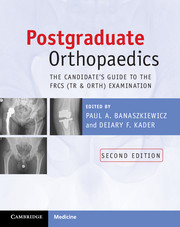Book contents
- Frontmatter
- Contents
- Contributors
- Foreword
- Preface to second edition
- Abbreviations
- Section 1 The FRCS (Tr & Orth) examination
- Section 2 The written paper
- Section 3 The clinicals
- Section 4 The adult elective orthopaedics oral
- Section 5 The hand oral
- Section 6 The paediatric oral
- Chapter 20 Paediatric oral core topics
- Section 7 The trauma oral
- Section 8 The basic science oral
- Section 9 Miscellaneous topics
- Index
- References
Chapter 20 - Paediatric oral core topics
from Section 6 - The paediatric oral
- Frontmatter
- Contents
- Contributors
- Foreword
- Preface to second edition
- Abbreviations
- Section 1 The FRCS (Tr & Orth) examination
- Section 2 The written paper
- Section 3 The clinicals
- Section 4 The adult elective orthopaedics oral
- Section 5 The hand oral
- Section 6 The paediatric oral
- Chapter 20 Paediatric oral core topics
- Section 7 The trauma oral
- Section 8 The basic science oral
- Section 9 Miscellaneous topics
- Index
- References
Summary
Introduction
This section is a brief overview of some of the more important paediatric topics that tend to appear regularly in the examination. It is not a comprehensive text but should point you towards the more important areas of the paediatric syllabus. Topics are included for two primary reasons:
They have been repeatedly asked in previous exams.
They are often the subject of confusion and textbooks are sometimes the source of it!
The paediatric oral can be tricky as the examiners expect you to have both a comprehensive range and depth of paediatric knowledge. Candidates may struggle unless they have had a reasonable working exposure to paediatrics, ideally 6 months as part of a higher surgical training rotation. Some topics are very predictable – in the oral candidates will invariably get one of the ‘big three’ (DDH, Perthes and SUFE), and not infrequently all three will come up.
- Type
- Chapter
- Information
- Postgraduate OrthopaedicsThe Candidate's Guide to the FRCS (Tr and Orth) Examination, pp. 357 - 396Publisher: Cambridge University PressPrint publication year: 2012



